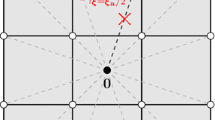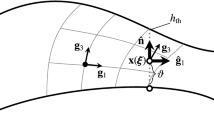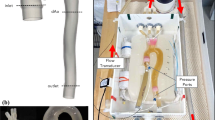Abstract
Numerical and analytical studies on cylindrical geometries have shown the relevance of accounting for residual stresses in arterial modeling. However, multiple difficulties, both geometrical and numerical, arise when enforcing residual stresses in patient-specific arteries. This is the reason of the few simulations that have been developed on this kind of geometries. In this paper we present a methodology that allows to include residual stresses in arbitrary geometries. Since it is not necessary to know the opened configuration of the artery, it makes it possible to take advantage of non-invasive image acquisition techniques such as CT or MRI to create customized arterial models. A simplified initial strain field showing its accuracy when applied to actual in vivo closed geometries is hypothesized from an opening angle experiment. In addition to residual stresses, the anisotropic hyperelastic and multilayered nature of the arterial tissue was accounted for the simulations of the behavior of a human coronary and iliac arteries. Results show the relevance of considering all these features for getting realistic results and the relative accuracy of using approximate solutions of residual stresses in patient-specific arterial simulations.



















Similar content being viewed by others
References
Chaudhry H., Bukiet B., Davis A., Ritter A., Findley T. (1997). Residual stress in oscillating thoracic arteries reduce circumferential stresses and stress gradient. J. Biomech. 30:57–62
Chuong C. J., Fung Y. C. (1983). Three-dimensional stress distribution in arteries. ASME J. Biomech. Eng. 105:268–274
Chuong C. J., Fung Y. C. (1986). On residual stress in arteries. ASME J. Biomech. Eng. 108:186–192
Delfino A., Stergiopoulos N., Moore Jr. J. E., Meister J. J. (1997). Residual strain effects on the stress field in a thick wall finite element model of the human carotid bifurcation. J. Biomech. 30:777–786
Dyke T. J. V., Hoger A. (2002). A new method for predicting the opening angle for soft tissues. ASME J. Biomech. Eng. 124:347–354
Fung, Y. C. Biomechanics. Mechanical Properties of Living Tissues. Springer-Verlag, 1993
Fung Y. C., Liu S. Q. (1989). Change of residual strains in arteries due to hypertrophy caused by aortic constriction. Circ. Res. 65:1340–1349
Fung Y., Liu S. (1991). Changes of zero-stress state of rat pulmonary arteries in hypoxic hypertension. J. Appl. Physiol. 70:2455–2470
Gardiner J. C., Weiss J. A. (2003). Subject-specific finite element analysis of the human medial collateral ligament during valgus knee loading. J. Orthop. Res. 21:1098–1106
Gasser T. C., Schulze-Bauer C. A. J., Holzapfel G. A. (2002). A three-dimensional finite element model for arterial clamping. ASME J. Biomech. Eng. 124:355–363
Han H. C., Fung Y. C. (1991). Species dependence of the zero-stress state of aorta: pig versus rat. ASME J. Biomech. Eng. 113:446–451
Himpel G., Khul E., Menzel A., Steinmann P. (2005). Computational modelling of isotropic multiplicative growth. CMES 8:119–134
Holzapfel G. A. (2000). Nonlinear Solid Mechanics. Wiley, New York
Holzapfel G. A., Gasser T. C., Ogden R. W. (2000). A new constitutive framework for arterial wall mechanics and a comparative study of material models. J. Elast. 61:1–48
Holzapfel G. A., Sommer G., Gasser C. T., Regitnig P. (2005). Determination of the layer-specific mechanical properties of human coronary arteries with non-atherosclerotic intimal thickening, and related constitutive modelling. Am. J. Physiol. – Heart Circ. Physiol. 289:H2048–H2058
Holzapfel G. A., Sommer G., Regitnig P. (2004). Anisotropic mechanical properties of tissue components in human aterosclerotic plaques. J. Biomech. Eng. 126:657–665
Imatani S., Maugin G. A. (2002). A constitutive model for material growth and its applications to three-dimensional finite element analysis. Mech. Res. Commun. 29:477–483
Liu S., Fung Y. (1989). Relationship between hypertension, hypertrophy, and opening angle of zero-stress state of arteries following aortic constriction. ASME J. Biomech. Eng. 111:325–335
Lubarda V. A., Hoger A. (2002). On the mechanics of solids with growing mass. Int. J. Solids Struc. 39:4627–4664
Marsden, J. E., and T. J. R. Hughes. Mathematical Foundations of Elasticity. Dover, 1994
Menzel A. (2005). Modelling of anisotropic growth in biological tissues. A new approach and computational aspects. Biomech. Model Mechanobiol. 3:147–171
Peña E., Calvo B., Martinez M., Doblaré M. (2006). A three-dimensional finite element analysis of the combined behavior of ligaments and menisci in the healthy human knee joint. J. Biomech. 39:1686–1701
Peña E., Martínez M. A., Calvo B., Doblaré M. (2006). On the numerical treatment of initial strains in soft biological tissues. Int. J. Numer. Meth. Eng. 68:836–860
Peterson S. J., Okamoto R. J. (2000). Effect of residual stress and heterogeneity on circumferential stress in the arterial walls. ASME J. Biomech. Eng. 122:454–456
Rachev A. (1997). Theoretical study of the effect of the stress-dependent remodeling on arterial geometry under hypertensive conditions. J. Biomech. 30:819–827
Rachev A., Greenwald S. E. (2003). Residual strains in conduit arteries. J. Biomech. 36:661–670
Raghavan M., Trivedi S., Nagaraj A., MacPherson D. D., Chandran K. B. (2004). Three-dimensional finite element analysis of residual stress in arteries. Ann. Biomed. Eng. 32:257–263
Rodriguez E., Hoger A., McCulloch A. (1994). Stress-dependent finite growth in soft elastic tissues. J. Biomech. 27:455–467
Schulze-Bauer C. A. J., Morth C., Holzapfel G. A. (2003). Passive biaxial mechanical response of agel human iliac arteries. ASME J. Biomech. Eng. 125:395–406
Simo J. C., Taylor R. L. (1985). Consistent tangent operators for rate-independent elastoplasticity. Comput. Methods Appl. Mech. Eng. 48:101–118
Taber L. (1995). Biomechanics of growth, remodeling, and morphogenesis. Appl. Mech. Rev. 48:487–545
Taber L. A. (1998). A model for aortic growth based on fluid shear and fiber stress. ASME J. Biomech. Eng. 120:348–354
Taber L., Eggers D. (1996). Theorical study of stress-modulated growth in the aorta. J. Theor. Biol. 180:343
Taber L. A., Humphrey J. D. (2001). Stress-modulated growth, residual stress, and vascular heterogeneity. ASME J. Biomech. Eng. 123:528–535
Vossoughi, J., Z. Hedzaji, and F. S. Borris. Intimal residual stress and strain in large arteries. In: Bioengineering Conference ASME, Bed-Vol. 24, 1993, pp. 434–437
Williamson S. D., Lam Y., Younis H. F., Huang H., Patel S., Kaazempur-Mofrad M. R., Kamm R. D. (2003). On the sensitivity of wall stresses in diseased arteries to variable material properties. ASME J. Biomech. Eng. 125:147–155
Acknowledgments
Financial support for this research was provided the Spanish Ministry of Science and Technology through the research project DPI 2004-07410-C03-01, the Aragón Government through the research project DGA PM009/2006 and the Spanish Ministry of Health through the research project FIS-PI06-0446.
Author information
Authors and Affiliations
Corresponding author
Rights and permissions
About this article
Cite this article
Alastrué, V., Peña, E., Martínez, M. et al. Assessing the Use of the “Opening Angle Method” to Enforce Residual Stresses in Patient-Specific Arteries. Ann Biomed Eng 35, 1821–1837 (2007). https://doi.org/10.1007/s10439-007-9352-4
Received:
Accepted:
Published:
Issue Date:
DOI: https://doi.org/10.1007/s10439-007-9352-4




